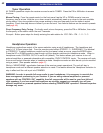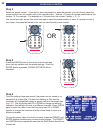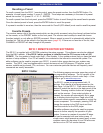
Material correctly mixed for Dolby Pro Logic contains no bass information in the surround channels and there-
fore, Dolby requires that no surround bass is mixed to the subwoofer when you have small surrounds.
However, many video game systems do end up with bass information in the surrounds. In order to prevent
loss of this bass information, PLIIx also provides GAME mode. GAME mode is otherwise identical to the
MOVIE mode. NEO:6 has no such requirements on surround bass - surround bass is allowed to be mixed to
the sub regardless of the mode selected. NEO:6 has no GAME mode.
The Surround mode is also used for multi-channel encoded bitstreams such as Dolby Digital and DTS-ES.
Selecting SURROUND-5 passes the 5 main channels unmodified to the fronts, center, and surround
speakers. Surround-6 engages Dolby Digital Surround EX or DTS Surround ES processing. Dolby Digital EX
must be selected manually. Both of these processes extract monophonic information from the surrounds and
places it in the back speaker(s). This is effective for material that has been mixed specifically for EX/ES, but
may drastically reduce surround information for material that is not specifically mixed for 6-channels. Dolby
provides a variation of Pro Logic IIx for processing surround and back channels for 5.1 material to make 7.1.
Press SURROUND-7 to access this mode. Back speakers will contain 2 independent channels (stereo
backs).
SURROUND-7 is the recommended mode for 5.1 material played back in seven channels. However, DTS
provides two variations for 6.1 material; DTS-ES Matrix (MTX) and DTS-ES Discrete. DTS-ES Matrix (MTX)
is specifically mixed to provide a single matrix surround back channel. The receiver will automatically select
SURROUND-6 for ES MTX material with the same surround back information in both back channels (mono).
DTS-ES Discrete (DSC) provides a completely independent discrete back channel. The receiver will
automatically select SURROUND 6 for ES DSC material.
Cinema Mode - As with 2-channel,CINEMA mode is identical to SURROUND mode except that it adds high-
frequency roll off to the front and center channels to compensate for certain movie soundtracks. In a movie
theater the left, center, and right front speakers are typically located behind the movie screen. The movie
screen tends to reduce the high frequency response. To compensate for this, movie soundtracks are mixed
with boosted high frequencies. Often, this compensation is not removed when transferring the movie to DVD.
B& K provides CINEMA mode to remove this undesirable high frequency boost. If a movie seems to have
overly bright or harsh sound, use CINEMA mode. CINEMA mode is otherwise identical to surround mode,
providing all of the same choices PLIIx, NEO:6, MOVIE, MUSIC, etc. However, CINEMA is not usually
required for music material.
DVD Audio (SACD) - Use this audio mode with the analog outputs of a DVD-Audio player or any other 5.1
analog audio source device. To quickly recall the DVD-Audio mode from the remote control, press the DVDA
button then the number of desired speakers 0-9 (see page 47). DVD-AUDIO - 5 is a direct analog pass-
through. No equalization is applied to the DVD Audio input.
Note: In order to select the DVD-Audio mode, the source input assigned to the DVD-Audio mode must be
selected before selecting the DVD-Audio mode. If no DVD Audio input is assigned (factory default), the DVD
Audio mode is inactive.
Why do I need all these audio modes?
With the wide variety of audio source material available today, i.e. 2 channel stereo, 2 channel surround and
multi-channel encoded audio, we believe that the reproduction of this material is best handled in audio
categories. We have decided to define these five "audio modes" which are actually different Plug and Play
modes of operating our audio processor. Simply selecting an audio mode will automatically recall a plethora
of user designated settings associated with each mode. Those settings are then applied to the audio signal
being received. The Plug and Play system simplifies the process further by automatically detecting a
bitstream and selecting a maximum number of speakers, so the user doesn’t have to. Any of the five Audio
Modes can be designated as “default” per each input.
OPERATION & CONTROL
46


















